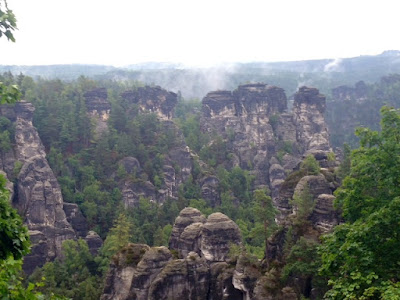I see castles and fortresses, and hillside vineyards; plains
of wheat and barley, and sandstone mesas… not in a fairytale book or romantic
novel, but in real life. Not exactly the kind of images one thinks of when
imagining Germany. But here they are, all
in front of me as the bus cruised along the hi-way taking us out of Dresden and
on to Saxon Switzerland, still in Germany, not Switzerland. It confused the heck out of me, but found out that the name was given by 2 Swiss artists pining for their homeland.
On my last full day in Germany, I joined a mid-morning to
mid-afternoon hiking tour of Saxony.
Mind you, the conference is ~11 hours long, so there was still plenty of
time to get my science fix, in addition to the exchanged pleasantries by
participants en route, which goes: “ what polymer do you work on?” or “Have you
tried such-and-such solvent system?”.
I have to admit, romantic
is not the first word that comes to mind when I thought of Germany prior to
this trip. It was more like – precision, museum, history, etc… But the quaint villages, fairytale-like
castles, and wildflowers dotting this drive along the snaking Elbe river makes
for great Hollywood scenery. Indeed, our
tour guide informed us that several scenes from the Grand Budapest Hotel, a film I adore, was shot in this region.
Hollywood-aside, the greens, rivers and distinctive landscape makes Saxony a dramatic
paradise just a short drive from Dresden.
 |
There's supposed to be a goose sillhouette there,
but as hard as I squint, I still couldn't see it. |
Our first stop was at the Sächsische Schweiz (Saxon Switzerland) National Park to see the Bastei rocks, a sandstone formation overlooking the Elbe River and offering
spectacular views of the Elbe valley, table top mountains and sandstone, and
forms the heart of the National Park. This park bordered Bohemian Switzerland,
which is in the Czech Republic. We crossed the sandstone Bastei bridge made of
sandstone rocks, cliffs and ranges. The rock formations and vistas have
inspired many artists, dubbing this place Painters’ Way, where painters once
sought inspiration for their masterpieces. Lucky me, I got to see it on a
dreary day – the painters’ favorite weather – and on a weekday with very few
people around.
 |
| Proof that I was there. Ha. |
 |
| The valley below and the mesa farther back |
As we continued on, we had to pay 2 euros to enter Felsenburg Neurathen (Neurathen Castle),
which was once a rock castle built in the 11th century, but now just
ruins. It’s still amazing to see how the people in that century built the
fortress by taking advantage of the rock cliff tops. I have no idea how they brought the catapults
and stone cannonballs up on top, but I guess in the name of defense, you do
what you got to do.
 |
| Basteibrucke |
 |
| Better pictures of the Basteibrucke here. |
 |
| Statue of a monk hauled up by brave rock climbers. |
 |
| (No, mom, I didn't climb up.) |
 |
| Old style defense: catapult with stone cannonballs |
Thankfully, I had a protein bar in my bag as we voted to
skip lunch and headed straight to Königstein Fortress, Europe’s highest
fortress, and covering an entire table mountain. There is really no way to
appreciate its massiveness and grandeur from my iPhone pictures, so here’s an aerial
photo snatched from the web, and my phone shots below.
 |
| Königstein - built by nature and man |
 |
| The valley below |
Königstein, or king’s rock, is a cleverly designed fortress –a mix of man-built genius and sweat extending the walls from its natural stone formations. It was deemed unconquerable and was a state prison for a time in the 1920s and was used as POW camp in WW I and II. Its castemates housed the state treasure and works of art from the famous Zwinger during war times. It’s easy to see why the fortress was never conquered in its 750-year history.
|
 |
| They meant business. |
 |
| Castle gates a la Game of Thrones |
 |
The current tennants -
He (and a hundred others) said hi to me |
As much as Dresden has taught me much about history, (and
ehem, given birth to the first milk chocolate), I am really touched most by Saxon
Switzerland’s unique and evocative landscape. How can something so beautiful
exist?! This tranquil region reminds me that
there is more to Germany than its war history. I used to think of Germany with somber tones
and hues, but no more. I’m glad I capped
this trip with the German countryside. And the lasting impression I’m leaving with is
of how a gem lies in East Germany – a place I’ll look forward coming back to.
This is the place where fairytales are born.




































